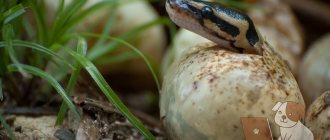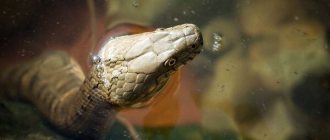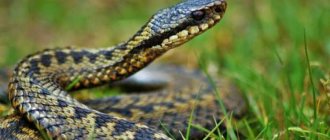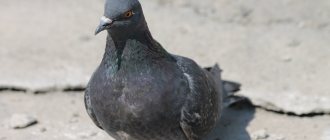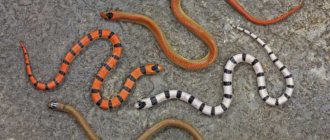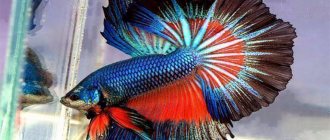In spring, nature and living creatures that have been sleeping all winter wake up. People also flock to forests to relax and enjoy the forest. In the forest there are dangers in the form of creeping snakes.
Most often in the forests of Russia there are snakes and vipers, which are similar to each other. And if a meeting with one of the snakes can be safe, then the other carries danger in the form of a poisonous bite.
Also, do not forget that snakes often crawl into residential courtyards and personal plots. Before driving away a snake, you need to find out whether it is dangerous and how to distinguish a snake from a poisonous viper.
On the left is a snake, on the right is a viper.
How to distinguish a snake from a viper - the main differences between snakes
If we describe the basic differences very briefly, then this is not a poisonous snake from the family Colubridae, but a viper - a representative of poisonous snakes from the viper family. Both snakes have quite pronounced external differences that you need to know in order not to get hurt when meeting a reptile.
The main difference by which one can understand that this is a snake and not a dangerous viper is two oval yellow spots located on the sides of the snake’s head. Sometimes such “ears” can be painted in other shades - cream or orange. The size of the spots can vary from completely invisible to large.
Both snakes are not aggressive and when meeting a person they try to get out of his way as quickly as possible. Only in immediate danger do they take a threatening pose, rush and bite. If an attack by a snake can simply frighten, then a viper’s bite is deadly. If a person makes no attempt to catch or hit the reptile, it will not attack on its own and will try to quickly crawl away. But all snakes become especially aggressive during the breeding season.
Character
Snakes are non-aggressive. They will never attack a person first. If you catch it, then after a short resistance and imitation of the viper (hissing, trying to bite the offender), it will pretend to be dead. Another option for protection is an unpleasant odor, which is emitted when there is danger. It scares away many animals.
The viper also tries to stay away from people, but if it is touched or provoked, it will attack. This snake is ready to take revenge on any offender, even if it is an inanimate object. She does this for a long time and frantically, not paying attention to the size of the offender and his attitude towards attacks on her part. There are cases when a viper fought with a stick, a stone, and even its own shadow, which seemed dangerous to it.
External signs
The difficulty of distinguishing by external characteristics lies in the fact that the color of the viper is variable depending on the place of residence and other factors. Vipers can be gray, almost black, brown, gray-brown, yellowish-brown or copper-red in color. Snakes can be dark or light, but the similarity in color does not mean that vipers and snakes are very similar. They have quite a lot of differences, both in anatomy and in the colors and patterns of scales, so you need to remember well how these creatures differ from each other.
Head, eyes and teeth
The easiest way to distinguish snakes is by their eyes, if you can see them. The viper has a characteristic vertical slit-shaped pupil, like a cat, while the snake has ordinary round pupils. The viper has a narrow, triangular, arrow-shaped head, flat, with rounded jaws, and looks noticeably smaller than the body. The snake has a large, oval head, without sharp planes, abruptly turning into the body. The colored “ears” are clearly visible on it.
Water snakes lack the characteristic yellowish spots where the “ears” are, but they are distinguished by a mark in the form of the Latin letter “V” where the head meets the body. The large fangs of a poisonous viper are clearly visible, but the harmless snake does not have them, only small sharp teeth.
Skin pattern
The skin of the snake has a specific “chessboard” pattern, consisting of darker spots on an olive light background. But in nature there are also monochromatic individuals - completely black or olive-gray. This makes the snakes vaguely similar to young snakes - the cubs of Nikolsky's viper.
However, all representatives of this family of snakes are distinguished by a characteristic zigzag pattern located along the ridge. At the same time, snakes can have a very diverse coloring: gray, brown, black, with a reddish or copper tint. There may be a scattering of light spots on the stomach. But even if the skin color is similar, comparing the patterns of a snake and a viper allows you to determine whether the snake in front of you is poisonous or harmless.
Expert opinion
Karnaukh Ekaterina Vladimirovna
Graduated from the National University of Shipbuilding, majoring in Enterprise Economics
Copperheads, representatives of the Colubridae family, may resemble vipers and snakes. Unlike other snakes living in Europe, vipers have a distinct distinctive feature. This is a thin black stripe running through the eyes, which have a round pupil, like all snakes. The copperhead reaches 80 centimeters in length, has a beige, gray or brown-brown color with dark spots located along the body. The viper's eyes have a characteristic red-brown hue (iris).
Body shape and length
Vipers have an average length of 75 centimeters, rarely reaching one meter. They have a narrower tail and head, which makes the body appear thicker in the middle. The body of vipers is more dense and muscular. Despite possible external similarities, these venomous snakes are significantly smaller than snakes that are harmless to humans.
They are larger in size and can reach two meters in length. The body of snakes is elegant, slender, without noticeable differences in thickness along the entire length. In natural conditions, they can often be found near ponds and other water sources. A large individual is rarely found in the human habitat, but small things, similar to large worms no more than 15-20 centimeters, are a common occurrence.
Tail
Vipers have a short tail, almost triangular in shape, often colored in a different color that stands out against the background of the body coloring - red, orange or yellow. This looks like an alarm warning that a dangerous creature is in front of you. The snake has a long tail, gradually tapering to the very tip, colored to match the body, with a blunt tip.
What types of snakes are there?
This non-aggressive and non-dangerous snake causes fear and hostility among most people. After all, not everyone knows what it looks like. You can meet him almost anywhere, but most of all he likes to live near bodies of water. In central Russia, the most common is the common snake, which has characteristic distinctive features - by these it is easy to distinguish it from the viper. But the water snake, living to the south, is very similar to its poisonous relative, since it also has a dark or black color. In the Far East there is a tiger snake that has poisonous teeth. He's something to be wary of. But now we are interested in the ordinary one and its difference from the viper. After all, this particular snake can be found in a country house or in a village yard, on the beach or in the forest.
Habitat and habits
Snakes are distributed throughout the globe with the exception of the polar regions. The common viper is found in forest-steppe regions of Europe and Asia, and like the grass snake, it loves quiet, damp areas, especially near water bodies. Most often, snakes lead a sedentary lifestyle, inhabiting abandoned rodent burrows, various caves, cracks in rocks and spaces between stones. This is due to the fact that when it gets cold, vipers hide in secluded places and hibernate for the entire winter.
Sometimes they choose places that are completely inappropriate, from a human point of view: seams in masonry, stacked cobblestones on an alpine hill, barns and barns, haystacks, and so on. For example, the Ural viper is black in color and very similar to an ordinary snake; moreover, it often crawls into the vegetable gardens and front gardens of summer residents and townspeople. But any snake will not attack first if it does not step on its tail, literally and figuratively.
Snakes also like to stay in damp places, prefer any water sources, and can even hide in small home ponds or unattended water containers. They lead a secretive lifestyle, becoming active at dusk, preferring to lie down in the shade on hot summer days.
However, in spring and autumn, when the nights are cold, both poisonous and harmless reptiles try to get out to bask in the warm rays of the sun on stones, fences, walls and roofs of houses, and garden structures. Care must be taken to ensure that children and pets do not try to grab the snake or attack it.
Social structure and reproduction
By nature, both vipers and snakes are loners and selfish. They live most of their lives alone, choosing a mate only during the mating season, which comes in the spring. At this time, snakes are very dangerous, because from an excess of hormones they become aggressive and can rush at a person, even if they are not in any danger.
The common viper reaches sexual maturity at 4-5 years of age, but this is largely due to the size of its body. The larger it is, the earlier it can enter the breeding season. About two weeks to a month after hibernation ends, mating season begins. Fights for the female are carried out in the style characteristic of reptiles: they curl into balls, hiss and threaten each other, but bloodshed and murder are rare among them.
The female bears offspring for 3 months, the viper gives birth to 5 to 12 active and viable vipers up to 15-20 centimeters long. Vipers live up to 10-15 years; unique individuals can live up to 30 years.
Expert opinion
Karnaukh Ekaterina Vladimirovna
Graduated from the National University of Shipbuilding, majoring in Enterprise Economics
Unlike vipers, snakes are not viviparous. They lay eggs, reaching sexual maturity by 3 years of age in males and by 4-5 years in females. Snakes are capable of laying collective clutches of several females, which can result in up to a thousand eggs in a nest. The incubation period for snakes takes 30-60 days; hatched snakes are completely independent and viable. They spread out and no longer need their parents.
Food preferences
Snakes are practically omnivorous, but they prefer animal rather than plant food. The assortment depends on the origin of the reptile. Some snakes catch small rodents, frogs and toads, fish, insects, lizards and other reptiles and reptiles, others eat larvae and earthworms, and can destroy bird nests, feeding on eggs and chicks.
Natural enemies
In nature, snakes have enough enemies, except for the most important and dangerous one - humans. These are birds of prey - storks, eagles, red kites, crows, magpies, jays. Snakes are hunted by mongooses, weasels, ferrets, stoats and their close relatives, hedgehogs, wild boars and even domestic pigs, on occasion, will not refuse to “bite” a poisonous snake without harm to themselves. They are protected from bites by a thick layer of fat.
Some non-venomous snakes can hunt their dangerous relatives. These include the copperhead, lizard snake, yellow-bellied snake and mussurana native to South Africa.
Snake nutrition
Snakes are excellent swimmers and often get their food not only on land, but also in water. The diet of snakes mainly consists of small vertebrates: amphibians and reptiles. However, there are lovers of rodents, birds and fish. Frogs are a delicacy for snakes. He catches them in the water and on the shore. A hungry snake swallows several small frogs at once. In the water, it also hunts tadpoles and fish.
Watching him eat is unpleasant. He swallows frogs alive, just as some people swallow live oysters. The discrepancy between the sizes of the frog and the snake makes the process of eating a terrible sight - the snake’s large mouth with a small head, a thin body in which the swallowed frog sticks out like a terrible knot... As a child, I once came across a snake with such a knot on its neck. I poked it with a stick - a live and unharmed frog jumped out from inside, it was still crawling, but it was completely white: the stomach juice of the snake had discolored it (Hans Scherfig “The Pond”).
The snake is said to hypnotize its prey. Externally it looks exactly like this. A. Nedyalkov saw with his own eyes how the frog obediently approached the snake:
I have been told many times that snakes hypnotize frogs. But this time the “hypnosis” did not take place. To see everything better, I pulled away a branch of the bush. The frog noticed the movement of the branch and made a desperate leap, turning over its head in the air. He continued to lie motionless. Looking closely, I saw that from time to time he threw out a forked tongue from his closed lips. I didn’t bother the snake and returned to my place. About five minutes later, near the same bush, the frog purred again. I approached the bush again. He was already lying in the same place, and the frog was purring again and approaching him. She did not jump, but, carefully moving her paws, crawled the way soldiers crawl on their bellies. This time I did not move the branches, and soon the frog approached the snake at a distance of twenty centimeters. Suddenly it rushed towards the frog and grabbed it by the end of its muzzle with its mouth. The frog struggled, but could not escape. Moving his jaws, he grabbed her tighter and tighter. The frog no longer purred, but desperately scraped the snake’s head with its paws. The snake's jaws kept moving and moving. The frog's eyes were already at the very edge of its mouth. I felt sorry for the frog, and I pushed the snake with the end of the grabber. He didn’t immediately let go of his victim. Only after I squeezed his neck quite hard with my grip, did he open his mouth and the frog escaped. She immediately jumped into the grass, and then slid into the thick of the bush... I don’t think he hypnotized the frog. Most likely, she noticed his moving tongue, mistook this tongue for a worm, wanted to eat this worm and herself became the prey of the snake (A. Nedyalkov “Naturalist in Search”).
The difference in the bite of a viper and a water snake
In the mouth of a viper, the poisonous fangs are in a “folded” state. When biting, it opens its mouth wide, the fangs move into a “fighting position”, and the poisonous glands fill them with poison. The bite of a poisonous snake occurs instantly, and it is almost impossible to react in time.
It usually does not attack a person, trying to crawl out of his way. He attacks, defending himself if his escape route is cut off.
Bite mark
After a viper bite, a mark in the form of two barely noticeable dots remains on the victim’s skin. However, the snake can bite several times in a row - up to 4-5, so there can be many holes, but they are located in pairs at the same distance from each other. After a snake bite, traces of small teeth remain. The wounds are shallow, but may bleed.
Symptoms of the victim
The viper has a strong neurotoxic venom, but bites are rarely fatal. Lethal cases can occur from multiple bites, attacks on a small child, or an allergic reaction. Hemorrhagic lesions in the form of hematomas occur at the site of the bite; with strong exposure, necrosis with loss of affected tissue is possible.
Swelling quickly develops at the site of the bite, the victim feels dizziness, weakness, nausea, headache, and difficulty breathing (shortness of breath). He is lethargic, has trouble thinking, and may be disoriented. Without urgent help, anemia, shock develops, and thrombosis occurs due to blood clotting in the vessels. In particularly severe cases, this leads to irreversible damage to the liver and kidneys. The bite is extremely painful. The snake's bite can be painful, but it is more frightening than harmful.
Treatment method and possible complications
The victim needs to be reassured, as panic contributes to an accelerated heartbeat and, as a result, speeds up the process of spreading the poison. The bitten person needs to move as little as possible. You need to lie in a horizontal position, do not move your limbs.
Expert opinion
Karnaukh Ekaterina Vladimirovna
Graduated from the National University of Shipbuilding, majoring in Enterprise Economics
You need to put ice or at least a cloth soaked in cold water at the site of the bite to relieve swelling, give a couple of antihistamine tablets, give plenty of fluids, call an ambulance or take yourself to the hospital. There he will be injected with a special serum that blocks the effect of the poison.
In critical cases, such as a bite to the upper body, suffocation may occur. Help must be provided within half an hour.
If a grass snake bites, the wounds must be disinfected with alcohol or Chlorhexidine. If the damaged area hurts and bleeds, the wound should be bandaged with a sterile bandage.
Characteristics of the common snake
Almost two-thirds of the snakes on the planet belong to the colubrid family. Today there are about one and a half thousand different species, and each of them has its own distinctive features.
And although the common viper and the common viper are very similar, the former differs from its poisonous relative in its peaceful and calm character.
A couple of hundred years ago in Ukraine there was a belief that if you offend a snake, you will suffer bad luck. The name of the city Uzhgorod also speaks about the popularity of snakes.
, located in western Ukraine, which has remained untouched to this day.
Distinctive features
The difference between ordinary snakes and other snakes is their “yellow ears,” pronounced markings on the head, most often yellow, but sometimes white and orange. It is extremely rare that marks are absent or weakly expressed. Females are larger than males. As a rule, the length of the snake is one meter, but there are individuals that reach a length of one and a half meters.
The reptile has dark gray, black or light gray skin. On individuals with gray skin, dark spots are very noticeable. On the light belly there is a dark stripe from the tail to the neck. The snake has round eyes, but there are individuals with a “cat-like” cut. The tail is 3-5 times shorter than the body and has a varied shape - sharp, steep, rounded. Some reptiles have smooth skin, while others have prominent ribs.
The description would not be complete without mentioning the reptile's teeth. Located at the top of the mouth, some of them enlarge when the pharynx opens. There are reptiles with immobile small teeth, and some have bent teeth. The tongue is already forked.
Reptile diet and life expectancy
Sometimes the common one feeds on insects, small birds and mammals. Favorite food: various amphibians:
- tadpoles;
- lizards;
- newts.
The lifespan of a reptile in captivity is no different from how many years it lives in the wild. As at home, the reptile lives in freedom for almost twenty years. Keeping such a reptile at home is not a good option.
, in this regard, it will be better if you get a less dangerous pet.
Reproduction in the natural environment
Reptiles can swim well and can stay under water for more than half an hour. As a rule, the mating season takes place in the spring in April-May and very rarely in the fall.
The mating courtship of snakes occurs without any complex elements; in one clutch, the female brings from eight to thirty eggs. To hatch eggs, she chooses the optimal place, for example, a pile of dry leaves, peat or sawdust. The birth period of the offspring is from one to two months.
The mating season begins in the spring
Final table
The easiest way to display the differences is in a table:
| Main differences | |
| Already | Viper |
| 1. Oval, egg-shaped head. 2. Round pupils in the eyes. 3. No fangs, only small teeth. 4. White, yellow or orange spots on the “ears” located behind the head at the transition to the neck (water snakes and some other members of the family may have no marks or they may be weakly expressed). 5. “Checkerboard” pattern on the skin of the back, small spots on the belly, also arranged in an alternating order. 6. Long thin tail with a smooth transition from the body | 1. Triangular spear-shaped or arrow-shaped head. 2. Vertical “cat” pupils. 3. Noticeable venomous fangs. 4. Zigzag pattern along the spine (in some cases it may be barely noticeable due to the rich or dark base color of the skin). 5. Wide, blunt triangular tail with a sharp transition from the body. |
| Snakes that are easily confused with each other | |
| Common snake | Nikolsky's viper |
| 1. Length – from 75 to 100 centimeters, in rare cases – up to 2 meters. 2. The color is black, with noticeable bright “ears” on both sides of the head. | 1. No more than 76 centimeters in length. 2. The color is black, in young snakes it is gray-brown with a dark brown zigzag pattern along the spine. |
| Water snake | Steppe viper |
| 1. 100-150 centimeters long. 2. Olive-colored skin with dark spots located in a checkerboard pattern. 3. There are individuals with a uniform color - olive or black | 1. Body length – up to 63 centimeters. 2. Brownish-gray color with a lighter belly, dark zigzag pattern along the ridge. 3. There is a series of small dark spots along the lateral parts of the body. |
| What to do when meeting a snake 1. Do not make sudden movements. 2. Slowly, smoothly take a few steps back. 3. Do not interfere with the reptile’s attempt to escape, do not block its escape route. 4. Do not try to move the snake with a stick or other objects, especially do not touch it with your hands. 5. Snakes attack only when there is an immediate threat to themselves or when protecting a nest with eggs or young. If you let her crawl away calmly, a dangerous collision can be avoided. | |
| Actions to take when bitten by a viper | |
| What is prohibited to do | Necessary actions |
| 1. You cannot apply a tourniquet. The concentration of poison in a certain area of the body can cause necrosis. 2. You cannot cut the bite site to allow blood to flow out, much less try to suck out the poison. This is useless, since from the wound it quickly spreads through the blood vessels. 3. You should not drink alcohol, as alcohol promotes the rapid spread of poison in the body. | 1. Give the person bitten by the viper an antihistamine. 2. Anyone bitten by a viper should drink plenty of fluids. 3. Take the victim to the hospital or call an ambulance, indicating that the person was bitten by a viper. |
Snake behavior
1. This snake is not at all aggressive and will never attack first; it would rather crawl away. Its only means of defense against predators is the ability to release a sharp, very unpleasant odor in moments of danger. At the same time, she may regurgitate all the food she has eaten. And if you pick it up, he most often pretends to be dead, hanging like a rope.
2. These snakes live near water and swim very well. But those who know what snakes look like have seen them on the roads, basking in the sun in clearings and even near human habitation. And in winter, in search of a warm place, they can even crawl into the house.
3. The main food of snakes is frogs and toads. These snakes actively hunt, quickly pursuing their prey and then catching it. Holding the victim with small sharp teeth, it gradually swallows it whole. Sometimes this snake can feast on fish, small rodents or birds, but this happens very rarely.
4. People get scared when they see a clutch of many eggs on the ground. After all, when snakes hatch, the sight is not very pleasant, especially if it happens near the house. But if everyone knew what snake eggs look like, the senseless extermination of this species could be avoided. The female lays them in a warm and humid place because their skin is very thin and dries out easily. The clutch consists of small round white eggs, often glued together.
Lifestyle
Snakes lead a diurnal lifestyle, they love the Sun, especially to bask in its warm rays, which they devote most of the day to, with the exception of the morning and evening - this is the time for hunting. Snakes also know how to climb trees, even move from branch to branch, swim well and can stay in the water for a long time. Many people have described cases where they saw a snake, for example, in the middle of a large lake.
There are species of snakes that are burrowing snakes; they dig real tunnels underground, and desert snakes are very fond of burrowing into loose soil and shoveling sand onto themselves.
Natural enemies of snakes
Photo: Already in nature
The snake is a relatively small reptile, far from being at the top of the food chain. These reptiles often become victims of other animals and even insects.
Adults are most often attacked by:
- foxes;
- minks;
- martens;
- eagles;
- storks;
- kites.
They also become prey for large venomous snakes. Cobras are not averse to feasting on them. People pose a certain danger to adults. Some catch them to keep them at home, others kill them for their own amusement. Snakes also die under the wheels of cars when they accidentally end up on the highway. Young animals and eggs of snakes are threatened by other dangers. Small snakes are eaten by birds and rats. Smaller rodents and even ants feast on eggs.
What does he eat?
Photo: Little one
The vast majority of snakes prefer to eat fish and amphibians. The most favorite “delicacies” are frogs, tadpoles, and various small fish. But in their absence, other representatives of amphibians - tree frogs, toads - also go as food. In addition, large reptiles can snack on lizards and other snakes, even their own kind. Sometimes lizard eggs become lunch.
Also often eaten are small insects, moles, rodents, small rats, voles, small birds, squirrels, chicks, and bird eggs. Burrowing reptile species eat mollusks, earthworms, small insects, larvae, and caterpillars.
Interesting fact: Snakes do not kill their prey before lunch. They swallow it alive. It’s easy to swallow small food, but the reptile has to tinker with large-sized prey. It happens that the ingestion process is delayed even for several hours.
Snakes have different hunting methods. On land they actively pursue their future food, and in water they can wait for hours for the right moment. Also, reptiles of this family cannot live without drinking plenty of water. They drink a lot of water, but can easily do without food. After a hearty meal, reptiles can fast for several days without any damage to their health.
Wintering
Where and how do snakes winter? With the arrival of winter cold, all the vital functions of these reptiles slow down, the snakes fall into hibernation, which begins in the fall and can last as long as 8 months, until the arrival of spring warmth. For wintering, snakes choose a secluded place that will not freeze during frosts. Often in such places several snakes can gather for the winter, and sometimes other snakes can even winter with them. With the onset of warmth, snakes crawl out of their winter shelters.
Video
And in addition, another useful video about the difference between a grass snake and a viper.
Author: Pavel Chaika, editor-in-chief of Poznavaika magazine
When writing the article, I tried to make it as interesting, useful and high-quality as possible. I would be grateful for any feedback and constructive criticism in the form of comments on the article. You can also write your wish/question/suggestion to my email [email protected] or Facebook, with respect, the author.
Author page
Breeding snakes
The mating season for these reptiles begins in the spring. One female attracts several males, all applicants intertwine with the female into one ball. The winner in this mating competition is the most dexterous male, who prevented everyone else from taking possession of the female.
After mating and fertilization, the female lays eggs. The average number of eggs in one clutch is 30 pieces. Future offspring are deposited in a warm, secluded place - heaps of leaves, sawdust, etc.
A month later, two of the eggs appear, small ones. Their body length at birth ranges from 14 to 22 centimeters. Baby snakes feed on small frogs, and in all other respects they behave like fully grown snakes. The coloring of babies is also no different from adults. Already in the third or fourth month of age, the Ugata babies become fully adult individuals and can themselves engage in breeding offspring.

